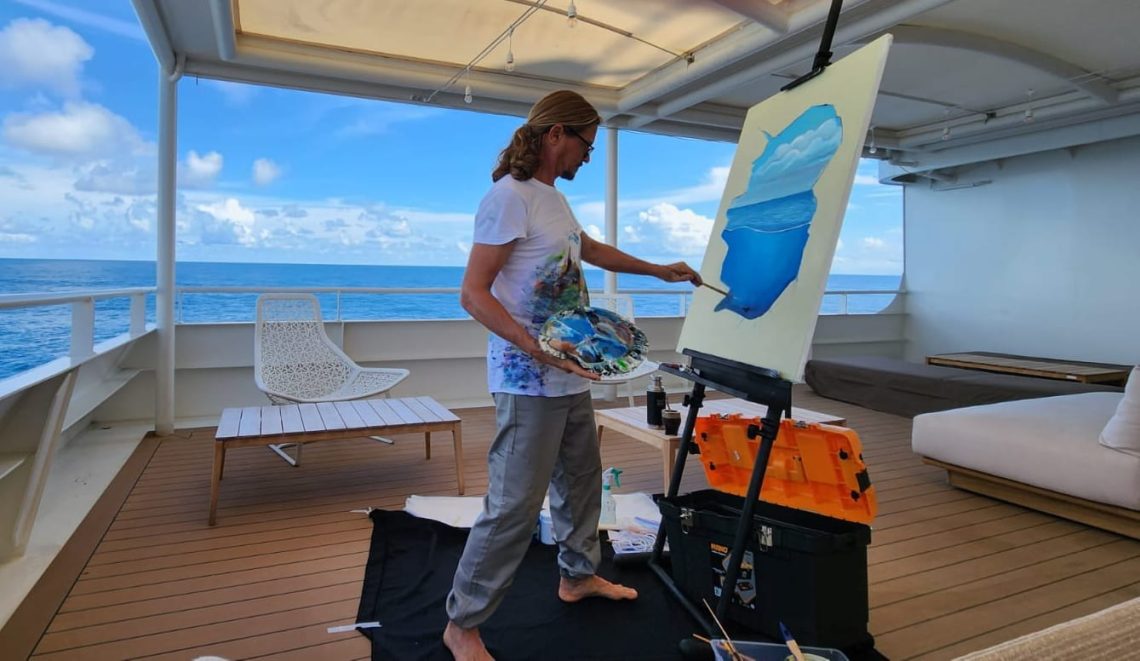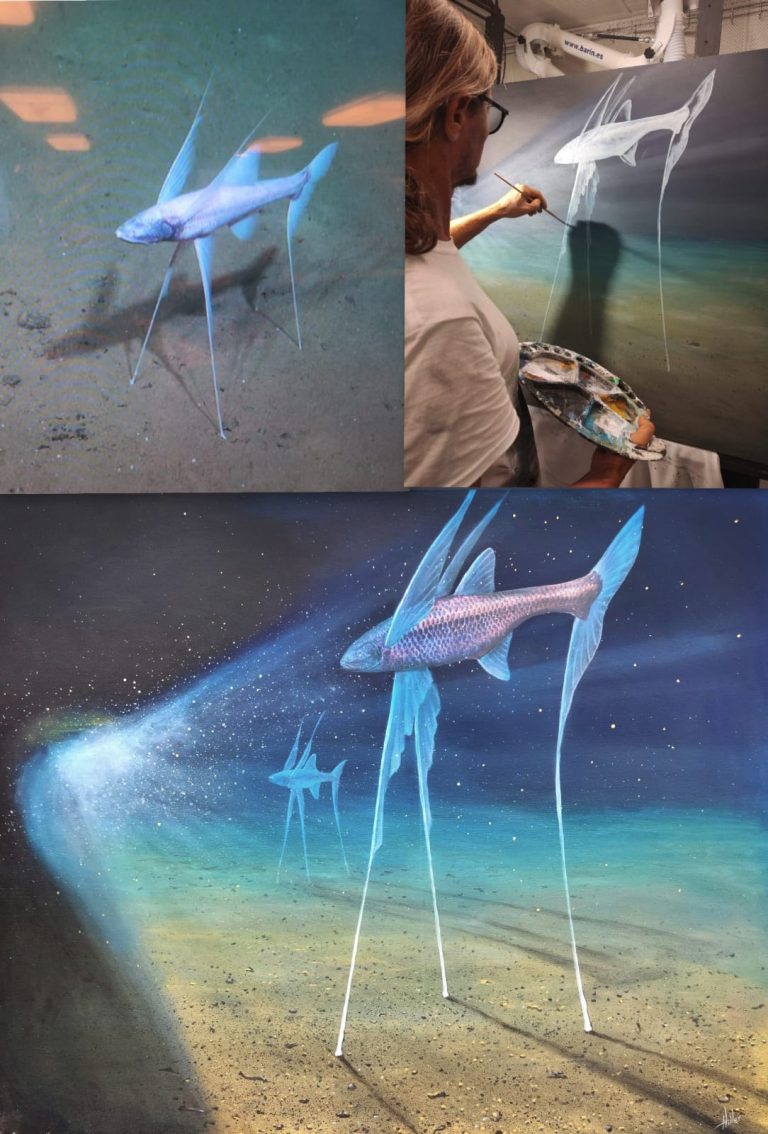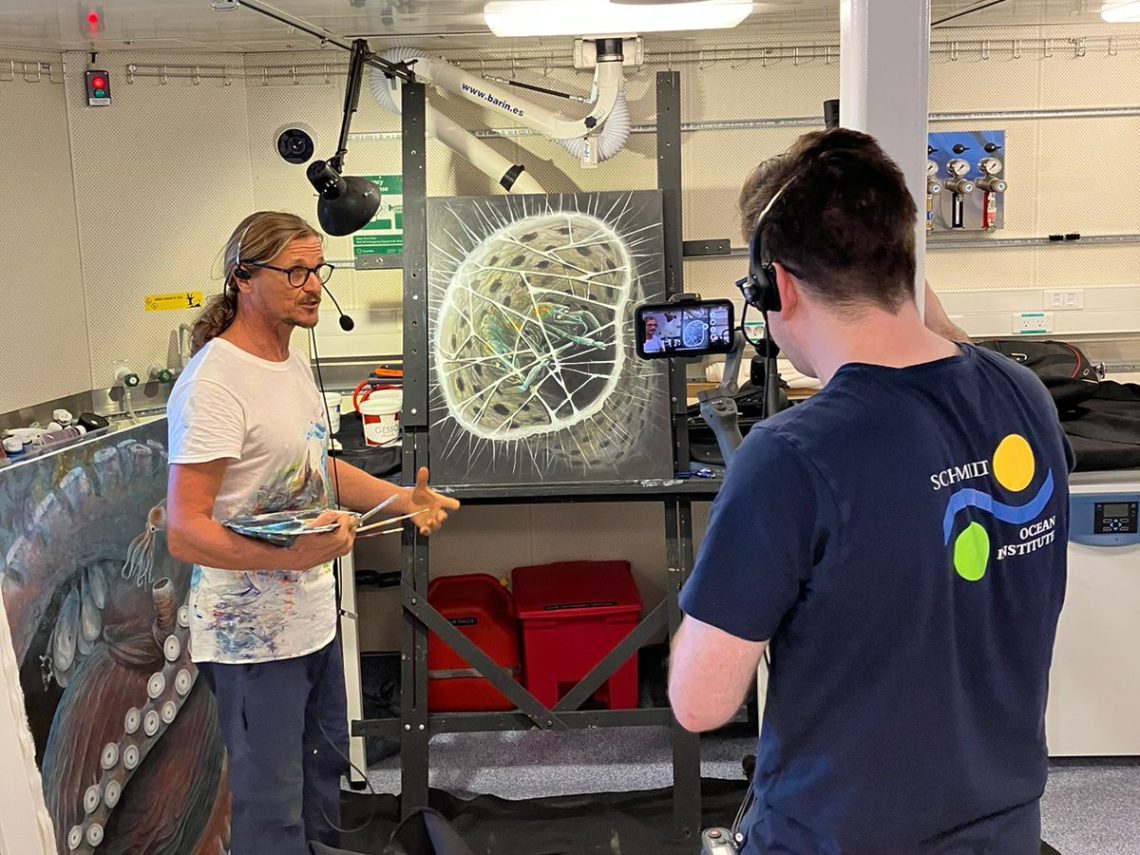English Translation Below
El explorador llega a un sitio donde nunca ha habido presencia humana. Se recorre el terreno palmo a palmo, y la vida es asombrosa en sus formas, tan diferente a lo ya conocido… El pintor a bordo es requerido inmediatamente para empezar a retratar con sus materiales de arte las nuevas especies para la humanidad…
Esta frase podría ser de una expedición del Beagle donde un Charles Darwin impaciente le hace notar detalles al artista a bordo llamado Martens. O bien de otra donde Ernest Shakleton le confía a Marston retratar los paisajes totalmente surrealistas de la Antártida.

La exploración, ciencia y arte han estado vinculados desde sus inicios. No sólo era una tradición, sino una necesidad, un servicio donde cada una complementaba a la otra.
Ya no quedan muchos lugares por conocer y el arte ya no es necesario para retratar nuevas especies y paisajes. Esta afirmación no es correcta: ¿Quién diría que aún queden zonas extensas por recorrer y descubrir? Donde prácticamente cada especie que vemos desafía nuestros conceptos normales de lo que es la vida. ¿Quién diría que el arte no le puede aún prestar servicios a la ciencia?

Como “Artista en el Mar” a bordo del R/V Falkor (too), del Schmidt Ocean Institute e integrante de la expedición científica “Octopus Odyssey”, mi misión es capturar a través de mi propia visión y estética todo lo que suceda, para poder transmitir con la ayuda de esta poderosa herramienta comunicativa que es el arte la importancia que tienen estas regiones que permanecieron hasta relativamente hace poco tiempo dejadas de lado por la falta de interés general, por lo lejanas, incomprendidas, pero fundamentalmente por lo inaccesibles.
Una vez convocado como artista, junto al también artista Michel Droge, fueron muchas reuniones virtuales, cursos, permisos… pero sé claramente que yo sólo llegué a visualizar la punta emergente del enorme iceberg de lo que es esta compleja expedición.

Llegado el día de embarcar en la ciudad portuaria de Puntarenas, Costa Rica, y ya todo el grupo a bordo del barco, quedamos impresionados (por lo menos yo) de la magnitud de todo esto. El Falkor (too) es una nave totalmente rediseñada para ser utilizada para la exploración científica y la ciencia. La presencia imponente en sus entrañas del vehículo operado remotamente (ROV por sus siglas en inglés) sumergible a hasta 4500 metros de profundidad, llama de inmediato la atención de todos nosotros. Su nombre es SuBastian, un juego de palabras que rinde honor al personaje principal del libro de Michael Ende “La Historia Interminable”. Ahora quizás saquen cuentas de por qué el nombre Falkor: el inseparable dragón vivaz y temerario que acompaña a Bastian en su gran búsqueda.
Mientras nos familiarizamos con el barco y recibimos las instrucciones necesarias de seguridad con sus respectivos simulacros, asistimos a reuniones organizativas. Aquí vienen sorpresas y enseñanzas para mi. El espíritu de colaboración y la increíble capacidad de organización. Se puede prever ese momento donde todo deberá funcionar a la perfección, ser preciso, inmediato, eficiente. Todas las muestras recogidas en el fondo oceánico deben estar debidamente clasificadas, pero por la complejidad y cantidad de las muestras, el sistema es discutido ampliamente, mejorado, entendido por todos. Se negocia, se realizan acuerdos, se cuestionan las cantidades y las formas de recolección. Todo esto me suena un poco exagerado en un principio. Hasta que llega el momento en que el SuBastian emerge triunfal de su primera inmersión y comprendo ya todo claramente.
Los pulpos.
La primera inmersión. El sitio: El Dorado. Un pequeño “monte submarino”, una elevación en el lecho marino que está a 3000 mtrs de profundidad y a 200 kilómetros mar adentro de la costa de la península de Nicoya en el Norte de Costa Rica. Este lugar fue previamente visitado hace una década. Súbitamente lo científicos vieron cientos, sino miles, de pulpos en una extraña posición, como vueltos sobre sí mismos, y que resultaron ser hembras cuidando sus huevos. En ese momento no se vieron que los huevos hayan sido viables por lo que había muchas preguntas por responder. Sí se sabía que elegían este preciso lugar porque entre las oquedades en las rocas emerge agua que está ligeramente mas cálida que el agua circundante. Por supuesto este afloramiento conlleva también muchos estudios geológicos y preguntas por responder.
Sin duda pueden remitirse a los blogs de los especialistas mismos para conocer de primera mano los aspectos científicos de esta apasionante expedición

De mi parte, puedo contarles que es un honor poder pintar especies y paisajes no vistos anteriormente por ojos humanos. Y que además mi estudio de arte esté precisamente en el laboratorio principal, donde en las varias pantallas gigantes vemos lo que acontece en tiempo real a miles de metros de profundidad. Puedo hacer consultas a los diversos especialistas, ver y fotografiar yo mismo las muestras de algunos de los ejemplares que pintaré, ser partícipe de las celebraciones cuando se suceden los momentos “Eureka”. ¡Ser yo mismo un explorador!
Te invito a explorar también este fascinante mundo submarino. En el canal de YouTube del Schmidt Ocean Institute podrás ver todos los videos en alta definición tal y como los vimos nosotros desde las pantallas del barco. Y quizás hasta puede ser que haya una nueva exploración en ese momento como para sentir la emoción de una transmisión en tiempo real.
Las pinturas realizadas a bordo de la expedición las puedes ir viendo en mi perfil de Instragram @carloshillerartist o e Facebook Carlos Hiller Artista. En www.carloshiller.com puedes ver el resumen de 24 años dedicados a retratar los océanos.
Espero que este esfuerzo, conjunción de ciencia y arte, resalte la importancia y belleza de este gran porcentaje (92% precisamente) del territorio costarricense, desconocido, ignorado, pero no por ello menos importante que una exuberante selva tropical. La ciencia confirma la importancia de estos ecosistemas con datos concretos. Yo, sólo le pongo bonito color a esos datos. Espero les guste.
The Colors of Science
The explorer arrives at a place where there has never been any human presence. The terrain is explored inch by inch, and life is astonishing in its forms, so different from what is already known… The painter on board is immediately called upon to begin capturing with art materials the new species for humanity…
This sentence could be from an expedition of the Beagle, where an impatient Charles Darwin points out details to the onboard artist named Martens. Or it could be from another expedition where Ernest Shackleton entrusts Marston with capturing the completely surreal landscapes of Antarctica.
Exploration, science, and art have been interconnected since their beginnings. It was not just a tradition but a necessity, a service where each one complemented the other.
There are still many places left to be explored and art continues to play a crucial role in portraying new species and landscapes. The statement that there are no longer many places left to explore and that art is no longer necessary is not correct. Who would say that there are not extensive areas yet to be explored and discovered? Where practically every species we encounter challenges our normal concepts of what life is. Who would say that art cannot still serve science?
As an “Artist at Sea” on board the R/V Falkor (too) of the Schmidt Ocean Institute and a member of the scientific expedition “Octopus Odyssey,” my mission is to capture, through my own vision and aesthetics, everything that unfolds. I aim to convey, with the help of this powerful communicative tool called art, the importance of these regions that remained overlooked until relatively recently. They were disregarded due to a lack of general interest, their remoteness, lack of understanding, but fundamentally, their inaccessibility.
I have been summoned alongside artist Michel Droge. There have been numerous virtual meetings, courses, and permissions. However, I am well aware that I have only glimpsed the tip of the enormous iceberg that this complex expedition represents.
Upon boarding the ship in the port city of Puntarenas, Costa Rica, and with the entire group already on board, we were impressed (at least I was) by the magnitude of it all. The Falkor (too) is a vessel entirely redesigned for scientific exploration and research. The impressive presence of the remotely operated vehicle (ROV) in its depths, capable of diving up to 4,500 meters, immediately captures everyone’s attention. Its name is SuBastian, a play on words that pays homage to the main character in Michael Ende’s book “The NeverEnding Story.” Now, you may do the math as to why it is named Falkor: the inseparable, lively, and fearless dragon that accompanies Bastian on his great quest.
As we familiarize ourselves with the ship and receive necessary safety instructions through drills, we attend organizational meetings. Here, surprises and lessons await me. The spirit of collaboration and the incredible organizational capacity are evident. One can anticipate the moment when everything must function perfectly, with precision, immediacy, and efficiency. All samples collected from the ocean floor must be properly classified. Due to the complexity and quantity of the samples, the system is extensively discussed, improved, and understood by everyone. Negotiations take place, agreements are made, and the quantities and collection methods are questioned. At first, this may seem a bit exaggerated to me. However, the moment arrives when SuBastian triumphantly emerges from its first dive, and I understand everything clearly.
Octopus.
The first dive. The location: Dorado Outcrop. A small underwater mountain, an elevation in the seafloor that lies 3,000 meters deep and 200 kilometers offshore from the Nicoya Peninsula in northern Costa Rica. This place was previously visited a decade ago. Suddenly, the scientists saw hundreds, if not thousands, of octopus in a strange position, turned inward, turned out to be females caring for their eggs. At that time, it was not known if the eggs were viable, leading to many unanswered questions. However, it was known that they chose this precise location because water slightly warmer than the surrounding water emerges from the rock crevices. Of course, this phenomenon also involves many geological studies and unanswered questions.
Undoubtedly, you can refer to the blogs of the specialists themselves to learn firsthand about the scientific aspects of this exciting expedition.
As for me, it is an honor to be able to paint species and landscapes that have never been seen by human eyes before. Moreover, my art studio is precisely located in the main laboratory, where on several giant screens, we can see what is happening in real-time thousands of meters deep. I can consult with various specialists, see and photograph the samples of some of the specimens I will paint, and be a participant in the celebrations when the “Eureka” moments occur. I get to be an explorer myself!
I invite you to explore this fascinating underwater world as well. On the Schmidt Ocean Institute’s YouTube channel, you can watch all the high-definition videos, just as we saw them from the ship’s screens. And perhaps, there may even be a new exploration happening at the moment, allowing you to experience the excitement of a live broadcast.
You can view the paintings created during the expedition on my Instagram profile @carloshillerartist or on Facebook Carlos Hiller Artista. On www.carloshiller.com, you can see a summary of 24 years dedicated to portraying the oceans.
I hope that this joint effort of science and art highlights the importance and beauty of this significant portion (precisely 92%) of Costa Rican territory. It is unknown and ignored, but no less important than a lush tropical rainforest. Science confirms the importance of these ecosystems with concrete data. I simply add beautiful colors to that data. I hope you enjoy it.

